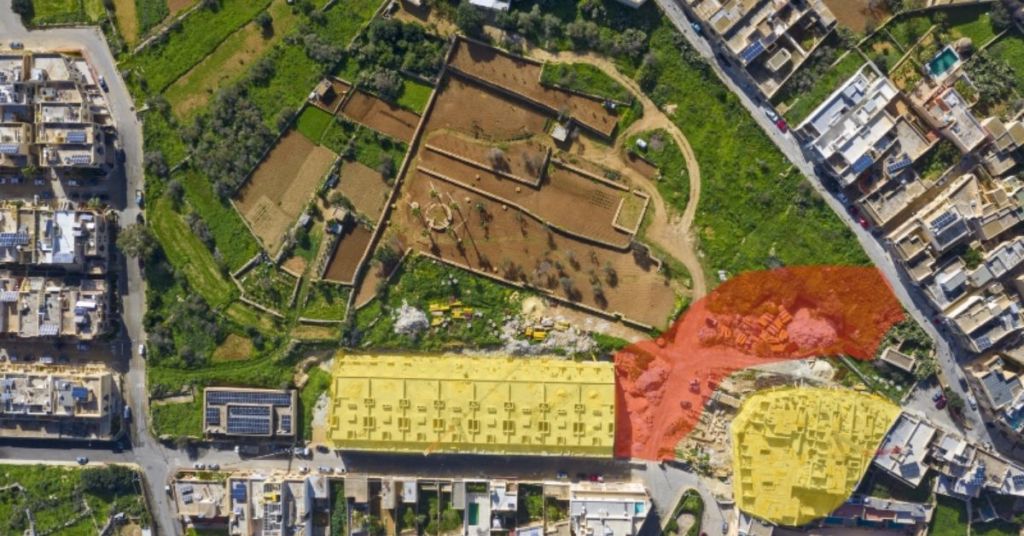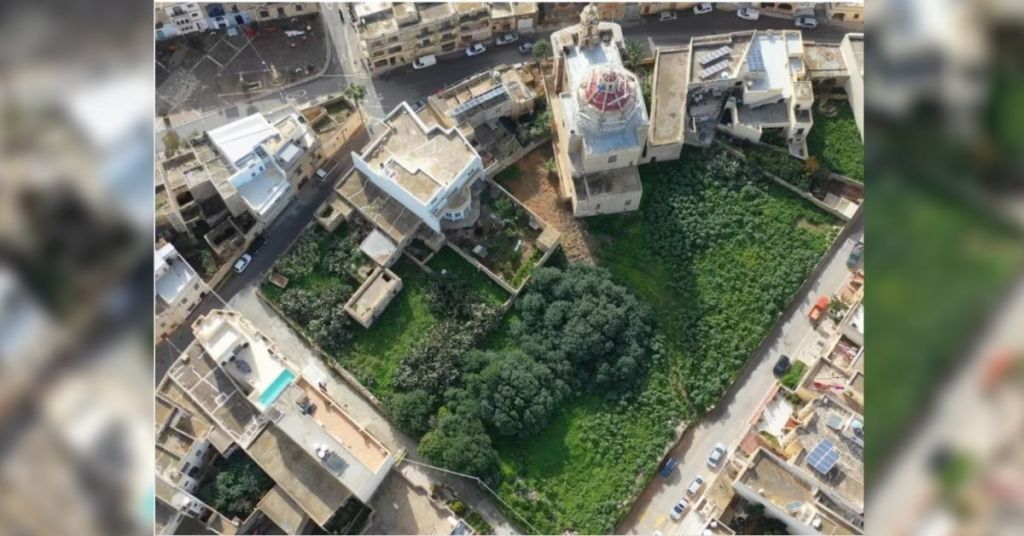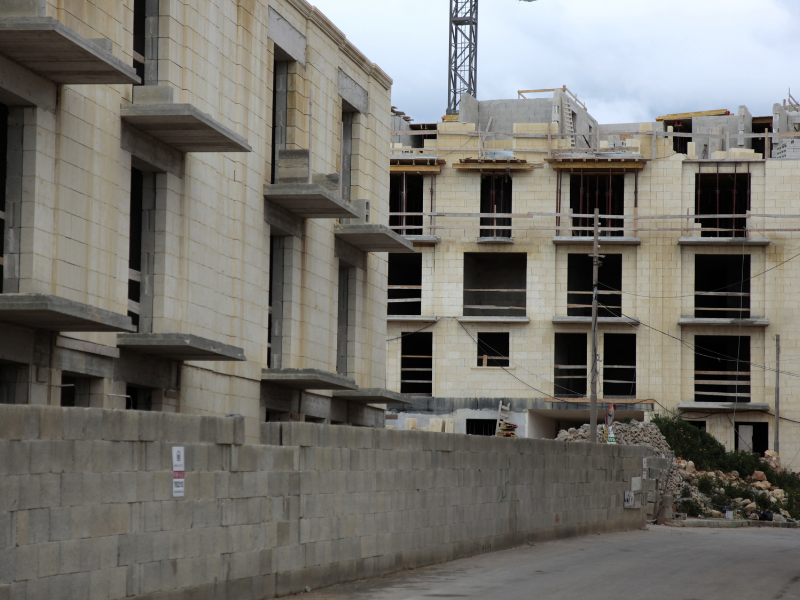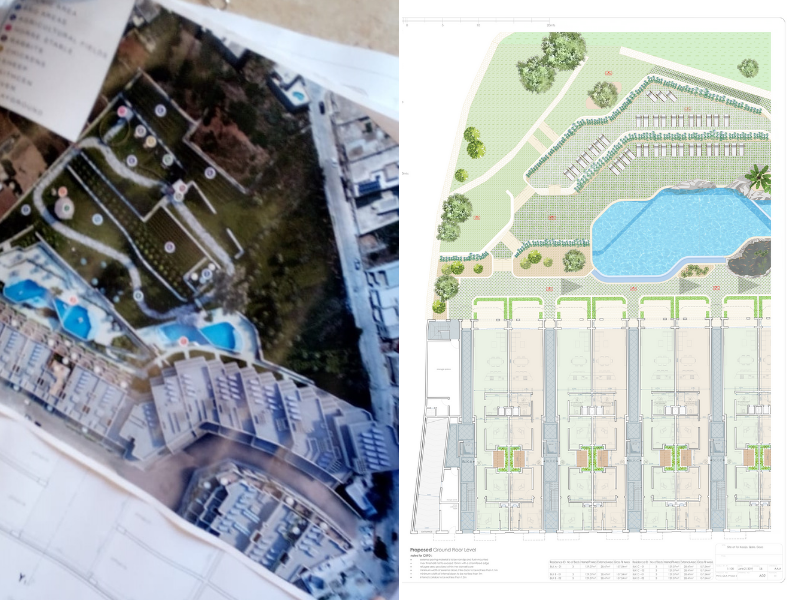Gozo Grab #6: Medieval Foundation’s First Land Acquisition To Turn Into 150 Qala Flats

A permit for 63 flats in Qala is expected to be approved on Tuesday for Gozo property magnate Joseph Portelli and his associates, sealing the fate of the first piece of land which fell under the orbit of a foundation which has been registering large swathes of land in eastern Gozo using medieval deeds.
The permit, which the Planning Directorate recommended for approval despite several controversial elements, will be the final block of flats in one of Gozo’s largest-ever residential developments. Around 100 flats have already been built by Portelli and his two partners Mark Agius and Daniel Refalo after several piecemeal permits were obtained apparently to circumvent EIA screening, and possibly a fully-fledged Environmental Impact Assessment (EIA).
The entire residential project is spread over an area called Ta’ Għar Boffa that is larger than three football grounds. The land was acquired by the people behind the medieval foundation. These include retired magistrate Dennis Montebello, lawyer Carmelo Galea and the Stagno Navarra family.
The issue is the subject of a joint investigation by Lovin Malta and The Shift after farmers and residents in eastern Gozo, mostly in Qala and Nadur, have been complaining of moves to deprive them of property they have held for generations.
These claims came to a head a year ago with the foundation’s registration of ownership of large lands in central Nadur on which dozens of houses stood, some of them bought by residents on a freehold basis.

It was in 1991 that the elder Stagno Navarra sibling, Richard, leased the land at Ta’ Għar Boffa to Joseph Vella, who a year later set up a company, Berracimp Properties Limited, which had three directors, including Galea and Montebello. Richard Stagno Navarra and Vella have since died.
The Archdiocese at the time had administrative control of the foundation – called Beneficcju ta Sant Antonio Delli Navarra, founded in 1675 to raise money for pious deeds – and spent more than two decades fighting Richard Stagno Navarra in court. One of Richard’s lawyers was Carmelo Galea. The Archdiocese won the court battle and grasped back control over the foundation in 2013.
Then, in 2017, after spending years arguing in court that the foundation fell under Canon law, the Archdiocese made a dramatic turnaround and recognised the Stagno Navarra siblings as heirs of the founder and granted their nominated rector, Patrick Valentino, administrative control over granting of the lands through emphyteusis.
Valentino is a lawyer and partner of Montebello’s daughter, Rachel, appointed magistrate in 2018.
Portelli acquired the land under preliminary agreement of emphyteusis in 2018 from Carravan Company Limited, a company owned by the Stagno Navarras, Galea, and a company of the Montebellos, Carrac Ltd, in which sitting magistrate Rachel Montebello is a shareholder.

Portelli then proceeded to develop the land into apartments.
The entire sprawling block of flats has a gross floor area of more than 30,000 square metres, which means that if a single application had to be put in, the Environment and Resources Authority (ERA) would have subjected it to an EIA screening. Planning sources said this would have probably let to a fully-fledged EIA and scrutiny procedure.
Instead, the development application was divided into four parts and applications filed under four names over a span of two years. Two of the applicants, Joseph Portelli’s daughter, Chloe Portelli, and his partner Daniel Refalo even falsely declared being the sole owners of the entire site in the application forms for the two parts for which they have submitted applications.
These two permits were later challenged by the Qala Local Council and Din L-Art Ħelwa, which filed legal proceedings to get the permits revoked. In a single hearing, only one member of the Planning Authority, ERA chairmanVictor Axiak, voted for revocation. The Qala Local Council spent more than €4,000 on revocation proceedings.
In the latest part of the project, recommended for approval on Tuesday, the Planning Authority’s case officer William Portelli made no analysis in the discussion part of the report of the proposed development within the context of the other parts of the project. He also made no analysis of the specific objections of Din L-Art Ħelwa about the “piecemeal applications”.
In its objection, the NGO wrote that “this vetting [EIA screening] process has been circumvented and the assessment of potential environmental impacts bypassed.” It added that it “is greatly concerned about the cumulative impact of these developments, especially given the scale of the proposal as a whole in relation to this locality.”
Din L-Art Ħelwa commented on the intensity and density of the block of flats, which is already evident in the completed blocks.

The NGO and another two objectors – the Qala Local Council and ERA – both pointed out that the proposed development protrudes beyond development lines.
ERA wrote of its concern that if this application is approved, “it would encourage further additions on site, such as future extensions to the building and construction of pools with hard surfacing and construction [on] ODZ [Outside Development Zone], which would lead to the proliferation and intensification of built development ODZ and significant uptake of rural land.”
Promotional material published by the developer, as well as a blueprint of the site, shows that this is already planned: the material shows two large swimming pools outback, with decking and lounge area and, beyond them still, a rural playground of sorts, with a fake windmill, paddock, picnic area and a few fields with crops. No development application for any of these have yet been submitted.

Yet the case officer states that, when analysing the protrusion into ODZ, “the encroachment is minimal, and most of it is covered by landscaping at ground floor.”
On the design elements of the building, particularly the façade, the case officer writes that it complies with the policy “which seeks to provide good urban design.” He then recommends approval.
The complex arrangement involved in acquiring the land is reflected in the sales contracts. Buyers of flats are getting their property on perpetual emphyteusis arrangements that could be converted into full ownership in the year 2039.
This is part of an investigative series being published jointly by The Shift and Lovin Malta about an ongoing land dispute in Gozo. The investigative team had strategic and research input by Caroline Muscat and Chris Peregin.
What do you think of this story? Comment below
